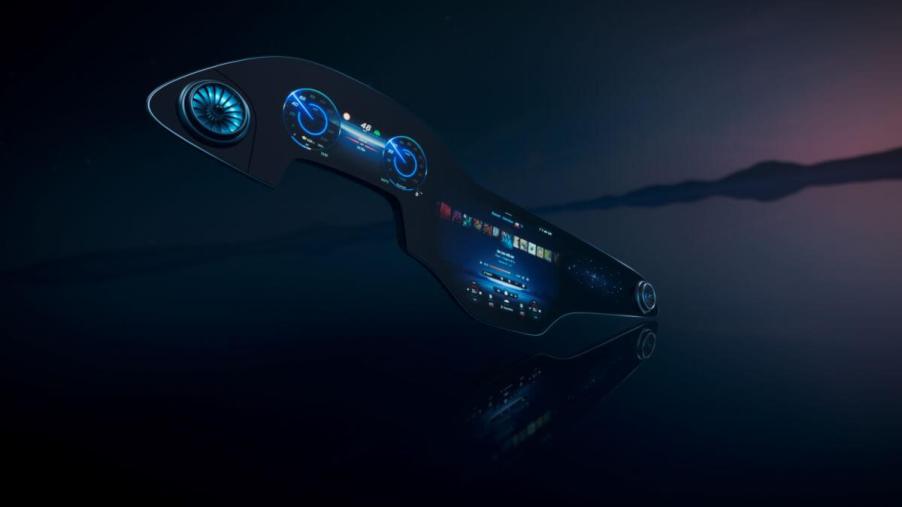
The Mercedes-Benz Hyperscreen Is Downright Cool and Not at All Necessary
Much of the automotive industry is publicly battling to introduce EV models and those with the most power, range, and efficiency. However, underneath the surface, another fight is raging — who can introduce the largest and most impressive infotainment display? Currently, Mercedes-Benz leads the pack with its massive 56-inch Hyperscreen available in some of its all-electric EQ offerings. Though incredibly impressive, the Hyperscreen is a bit overkill.
The Mercedes-Benz Hyperscreen is an impressive tech showcase
The Mercedes-Benz Hyperscreen is effectively three large displays housed under a single piece of curved glass. The displays — a 12.3-inch unit for both driver and passenger and a 17.7-inch center display — total 56 inches. This length spans the distance from A-pillar to A-pillar in the Mercedes EQS Sedan and EQS SUV, the two models in which the Hyperscreen debuted.
With eight CPU cores, 24 gigabytes of RAM, and 46.4 gigabytes per second of RAM memory bandwidth, the Hyperscreen has the incredible computing power to be fitted to a car. This allows the Hyperscreen to use Mercedes’ “Zero Layer” tech, essentially an AI tool that prioritizes touchscreen inputs tailored to the driver’s most common uses. For instance, if you often use Bluetooth audio, the Hyperscreen will add a “button” for the function on the main screen for easier access.
The passenger screen effectively operates independently from the digital gauge cluster and center display. The passenger display can be used for audio controls, navigation, or system settings while the driver is occupied, or just to play games when boredom strikes. If the model doesn’t detect a front passenger, a few displays, such as a compass, that act as placeholders — likely so the far screen doesn’t distract the driver.
The Hyperscreen’s computing power and haptic feedback deliver quick responses, and there are seemingly endless menus and ways to customize display settings. Drivers can spend the better part of a day simply playing with the system. To boot, the displays are simply gorgeous, with fantastic colors and a crispness that even a deep-fried crouton can’t match.
Overall, the Hyperscreen is beautiful, powerful, intelligent, convenient, and, although ridiculously impressive, not particularly necessary.
The Hyperscreen is great, but not worth the added price alone
The Hyperscreen is equipped with the top trims of the Mercedes-Benz EQS SUV and EQS Sedan. That is to say, they are fitted in models featuring the “580” designation. Models bearing the “450” moniker are instead equipped with a 12.3-inch driver’s display and a tablet-like 12.8-inch OLED center display. Last year, I piloted the EQS 580 in both the sedan and SUV versions with the Hyperscreen. More recently, I tested the 450 SUV and AMG-EQE sedan, both of which use the luxe but less impressive dual-screen setup.
The lack of a Hyperscreen in the latter models did take away some of the “wow” factor of Mercedes’ airy and upscale electric cabin design. Climbing into models equipped with the Hyperscreen and seeing the entire dash light up with beautiful displays is impressive enough to motivate tech-savvy or screen-centric buyers to dish out more than $100,000 grand on an EQS model just for that experience alone.
But I didn’t miss the Hyperscreen.
Mercedes’ 12.3- and 12.8-inch displays were about all the functionality that was really needed. They operate, at least to the everyday user, in the same capacity as the Hyperscreen, just with a smaller central display and no screen for the passenger.
Getting the Hyperscreen also requires opting for one of the EQS 580 models. While these models come with significantly more power — the 580 dishes out 516 horsepower, the 450 settles for 329 horses — and more luxe features, they also require a massive uptick in price. The EQS 450+ Sedan starts at $104,400 MSRP, while the Hyperscreen-equipped 580 model commands an additional $21,550. It seems hard to justify spending the same amount of money as a base 2023 Toyota Corolla just for the Hyperscreen when the standard displays function just as well.
Overall, the Hyperscreen is a technological showcase that beats the pants off similarly large display units from Cadillac or Lucid Motors. However, Mercedes-Benz’s “standard” dual screens will still please tech-centric buyers and those seeking an upmarket MBUX experience.




